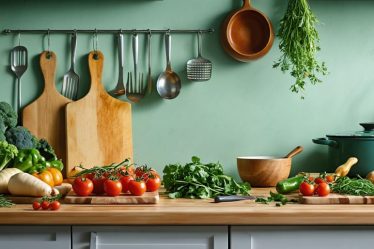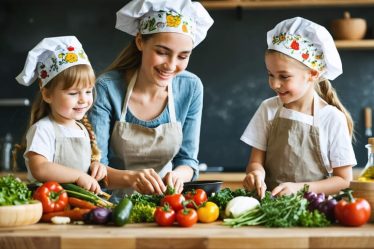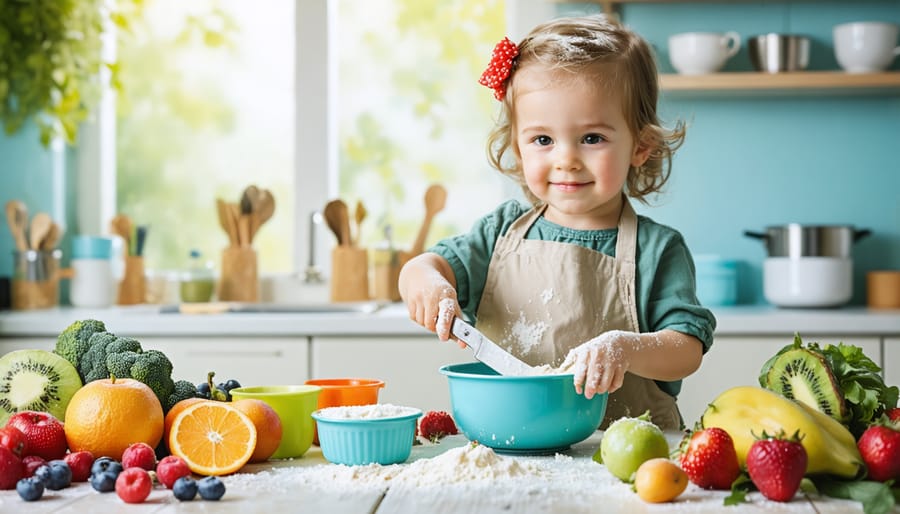
Transform your kitchen into a magical learning lab where little hands discover the joy of cooking! Nothing gets kindergartners more excited about healthy eating than creating their own culinary masterpieces. Beyond the giggles and inevitable mess, cooking activities offer profound educational benefits for 5-6 year olds, from building math skills through measuring to enhancing fine motor development while stirring and pouring.
As both a parent and early childhood educator, I’ve witnessed countless “aha” moments when children realize they can transform simple ingredients into delicious treats. These kitchen adventures become powerful learning opportunities where science, math, and creativity seamlessly blend with life skills. Whether you’re a teacher looking to enhance your curriculum or a parent seeking meaningful activities at home, cooking with kindergartners opens up a world of discovery that engages all their senses while building confidence and independence.
Let’s explore age-appropriate cooking activities that spark joy, learning, and lasting memories in your young chefs – all while keeping safety and fun at the forefront of every culinary adventure.
Kitchen Safety First: Creating a Child-Friendly Cooking Space
Safe Kitchen Tools for Little Hands
When introducing little ones to the joys of cooking, having the right kitchen tools and gadgets is essential for both safety and success. Start with plastic measuring cups and spoons, which are perfect for little hands to grasp and won’t break if dropped. Child-safe nylon knives are fantastic for practicing cutting soft foods like bananas or cooked vegetables – they’re sharp enough to cut food but not little fingers!
Rolling pins sized for children, silicone mixing bowls that won’t slip, and plastic cutting boards provide a safe foundation for budding chefs. I’ve found that egg whisks with cushioned handles are particularly popular with my kindergarten cooking classes – they make mixing fun and manageable for small hands.
Don’t forget about protective gear! Child-sized aprons with adjustable necks, non-slip stepping stools, and colorful oven mitts designed for kids help create a safe cooking environment. Remember, these tools aren’t just toys – they’re real cooking implements scaled down for safety and convenience, helping children develop genuine cooking skills while staying safe in the kitchen.
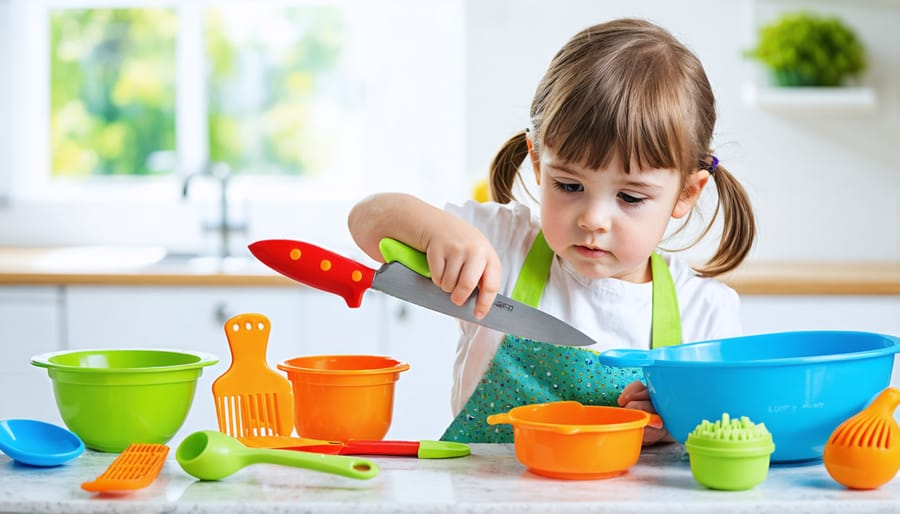
Basic Kitchen Rules for Preschoolers
Safety in the kitchen starts with these fun and easy-to-remember rules that every little chef should know! Let’s turn these basic guidelines into mindful cooking habits that your preschooler can practice every time they help in the kitchen.
Always wear an apron and roll up those sleeves! Just like superheroes need their capes, little chefs need their special cooking gear to keep clean and safe. Remember to wash those hands with soap and water – we can make it fun by singing the ABC song while scrubbing!
The “Ask First” rule is super important: never touch kitchen tools, turn on appliances, or open cabinets without a grown-up’s permission. Hot surfaces are for grown-ups only, so keep those tiny hands away from the stove and oven.
Walking feet only in the kitchen – no running or dancing! And remember our special chef’s secret: if you see something spill, let a grown-up know right away. These simple rules help make cooking time both safe and super fun for everyone involved!
No-Cook Kitchen Activities
Snack Assembly Adventures
One of my favorite ways to introduce cooking to kindergarteners is through simple snack assembly activities. These no-cook creations allow children to exercise their creativity while developing fine motor skills and learning about healthy food choices.
Fruit kebabs are always a hit in our kitchen adventures. Set out a colorful array of cut fruits like strawberries, grapes, melon chunks, and banana slices, then let the little ones thread them onto child-safe skewers. I’ve seen such pride in their eyes when they create their own rainbow-inspired patterns!
Sandwich art takes lunch to a whole new level of fun. Provide cookie cutters to transform plain sandwiches into stars, hearts, or animals. Children can then use vegetable toppings to create faces or designs. Think cucumber eyes, carrot smiles, and cherry tomato noses – the possibilities are endless!
Trail mix assembly stations are another engaging activity. Set up small bowls of cheerios, dried fruits, pretzels, and child-safe nuts (if allowed), and let kids measure and mix their own combinations. This activity naturally incorporates counting and sorting skills while teaching about portion sizes.
Remember to make food safety part of the fun by having children wash their hands first and wear child-sized aprons. These simple assembly activities often lead to more adventurous eating habits, as children are more likely to try foods they’ve helped prepare themselves.
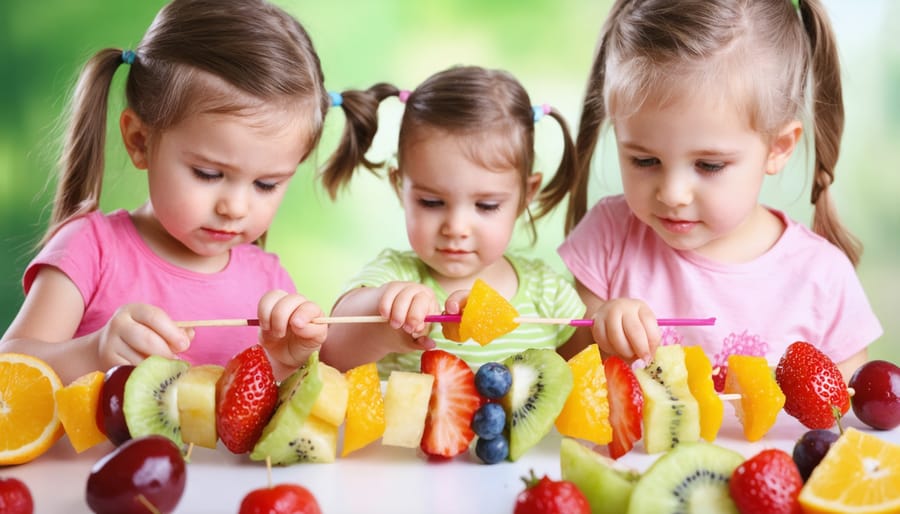
Mixing and Measuring Magic
One of my favorite activities with my kindergarten class is what we call our “kitchen scientist” sessions, where we explore the fascinating world of measuring and mixing dry ingredients. It’s amazing how something as simple as scooping flour can teach valuable math and motor skills!
Start by gathering child-safe measuring cups, spoons, and clear containers. I find that plastic measuring tools work best for little hands. Set up a workspace with easy-to-handle ingredients like rice, oats, or flour (just be prepared for some cleanup afterward!).
Let your little chefs practice filling and leveling measuring cups with different ingredients. Make it fun by creating “magic potions” where they can combine various amounts of colorful ingredients like rainbow sprinkles and colored sugar. For added excitement, try layering different colored ingredients in clear jars to create beautiful patterns.
To keep things educational, introduce basic fractions naturally through measuring – “We need one half cup of oats and one quarter cup of cereal.” You’ll be surprised how quickly they grasp these concepts when they’re having fun!
Remember to encourage exploration and creativity, even if measurements aren’t perfect. The goal is to build confidence and foster a love for kitchen activities. Keep paper towels handy and embrace the occasional spill – it’s all part of the learning process!
Simple Cooking Projects for Tiny Chefs
Easy Baking Projects
Baking with kindergarteners is a delightful way to introduce them to the joys of cooking while creating sweet memories together. As a mom who’s hosted countless baking sessions with my daughter’s kindergarten friends, I’ve found that simple baking projects are perfect for little hands and growing minds.
Cookies are an excellent starting point for young bakers. Sugar cookies are particularly kid-friendly because children can help measure ingredients, mix the dough, and use cookie cutters to create fun shapes. Let them decorate their creations with sprinkles or safe icing options – just be prepared for some creative color combinations!
Muffins are another fantastic choice for kindergarten bakers. Basic banana or blueberry muffins allow children to practice skills like mashing bananas, counting ingredients, and filling muffin tins. The best part? They’ll have a sense of pride when sharing their homemade treats with family.
Quick breads, like pumpkin or zucchini bread, are also wonderfully simple projects. Kids can help pour pre-measured ingredients into bowls and practice stirring – though you’ll want to handle any oven-related tasks yourself.
Pro tip: Set up a “mise en place” (everything in its place) before starting. Pre-measure ingredients into small bowls, letting children pour them into the mixing bowl when needed. This prevents overwhelming them with too many tasks at once and keeps the experience positive.
Remember to embrace the mess – it’s part of the learning process! Keep paper towels handy and consider using silicone baking mats to make cleanup easier. The joy on their faces when they see their finished baked goods is worth every sprinkle on the floor.
Fun with Fresh Foods
Getting kids excited about fresh fruits and vegetables is easier when you make it fun and hands-on. One of my favorite activities is creating “rainbow plates,” where children arrange different colored produce to make beautiful designs. This not only teaches them about healthy food choices but also engages their creativity.
Start with simple tasks like washing fruits and vegetables, which helps develop motor skills while teaching food safety. Let them use plastic knives to cut soft fruits like bananas or strawberries, always under close supervision. Making faces on plates using cucumber circles for eyes, cherry tomato noses, and bell pepper smiles never fails to bring giggles to the kitchen.
Try the “blind taste test” game where kids guess different fruits and vegetables while blindfolded. This builds trust and encourages them to try new foods without pressure. Another winning activity is creating “veggie stamps” – cutting bell peppers, apples, or celery stalks in half and using them as natural paint stamps with child-safe food coloring.
For a science twist, experiment with floating and sinking fruits in water, or explore how vegetables change color when cooked. My students particularly enjoy our “garden in a bag” activity, where we sprout seeds in clear plastic bags, allowing them to watch the growing process up close.
Remember to praise their efforts and maintain a positive atmosphere, regardless of whether they want to taste everything. The goal is to make fresh foods familiar and fun, creating positive associations that last a lifetime.
Learning Through Cooking
Math and Science in the Kitchen
The kitchen is a natural laboratory where kindergarteners can explore math and science concepts through hands-on experiences. When my daughter and I bake cookies together, we practice counting as we add chocolate chips one by one, and she’s learning fractions without even realizing it as we measure half cups of flour.
Simple recipes provide endless opportunities for mathematical thinking. Children practice number recognition when reading recipe cards, develop counting skills while gathering ingredients, and begin to understand measurement concepts using cups and spoons. They’ll naturally start comparing quantities – more, less, half, double – as they help prepare ingredients.
The science of cooking is equally fascinating for young minds. Watch their eyes light up as they observe how heat transforms raw eggs into fluffy scrambled breakfast, or how mixing baking soda and vinegar creates bubbles in cake batter. These hands-on experiences introduce basic chemistry concepts like states of matter (melting butter), chemical reactions (rising dough), and physical changes (dissolving sugar).
You can enhance these learning moments by asking open-ended questions: “What happens when we mix these ingredients?” or “How many more spoonfuls do we need?” These conversations not only reinforce learning but also develop critical thinking skills. Remember, the goal isn’t perfect measurements or precise scientific understanding – it’s about fostering curiosity and making connections through everyday kitchen adventures.

Building Language and Social Skills
Cooking together creates the perfect environment for children to develop their language and social skills naturally. As you measure, mix, and create in the kitchen, your little ones are absorbing new vocabulary and learning how to work as part of a team. I’ve noticed how my own kindergarten cooking classes become buzzing hubs of conversation and cooperation!
When children work together on a recipe, they practice essential social skills like taking turns, sharing utensils, and following directions. They learn to communicate their needs (“Can you pass the spoon?”) and express their observations (“The dough feels sticky!”). These interactions build confidence and enhance their ability to work with others.
The kitchen also provides endless opportunities for expanding vocabulary. From ingredient names to cooking verbs like “whisk,” “fold,” and “sprinkle,” children naturally pick up new words in context. Make the most of these teaching moments by describing textures, tastes, and smells as you cook together.
Try encouraging questions and discussion during your cooking sessions. Ask your little chefs to predict what might happen next or describe what they’re doing. This not only builds language skills but also helps develop critical thinking abilities. Remember, even simple activities like making a sandwich can become valuable learning experiences when you engage in meaningful conversation throughout the process.
Cooking with your kindergartener is more than just a fun way to spend an afternoon – it’s an investment in their development and your relationship. As we’ve explored throughout this article, these kitchen adventures offer incredible opportunities for learning math, science, and language skills while building confidence and independence. I’ve witnessed firsthand how my daughter’s face lights up when she measures ingredients or successfully flips a pancake, and these moments are truly priceless.
The beauty of cooking with preschoolers lies in its versatility. Whether you’re making simple fruit kabobs or decorating cookies, each activity can be adapted to your child’s skill level and interests. These shared experiences create lasting memories while teaching valuable life skills that will serve them well beyond their kindergarten years.
Remember, there’s no need to feel overwhelmed about getting started. Begin with simple recipes and gradually introduce new skills as your child grows more comfortable in the kitchen. The mess and occasional spills are all part of the learning process, and the pride in your little one’s eyes when they serve their first homemade snack makes it all worthwhile.
So grab those child-sized aprons, clear some counter space, and embark on this delicious journey with your kindergartener. The kitchen is waiting to become your classroom, playground, and memory-making factory all rolled into one. Your little chef’s culinary adventure starts today!

